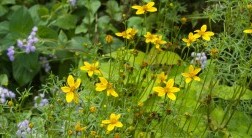Anything that can hold soil can serve as a home for plants—which expands the selection into realms far beyond the standard terra-cotta flowerpot or ubiquitous plastic window box. Choose from a vast array of traditional, innovative, daring, whimsical, or intriguing designs ranging from lucky flea market finds to costly antiques: a discarded wicker basket, a strawberry jar, a coal bucket with a new lease on life, a leaky soup tureen, a milk crate, a footed lead urn, an authentic Ming vessel, or a Victorian chimney pot.
A potted planting begins with the container. The container you select is as important to the overall design scheme as the plants you decide to grow in it. Delicate antique ceramic and porcelain finds (minton ware, McCoy, and majolica, for example), and jardinières, arborettes, jardinets, and cachepots make wonderfully unique planters—especially when they are overflowing with your favorite annuals and herbs. However, their fragility and expense warrants a sheltered (wind-free) spot in the garden during the summer, and, in colder climates, a frost-free spot for the winter, where they can await the next growing season emptied of plant material and soil.
Strawberry Jars
Particularly favored by Victorian gardeners, the aptly named containers with the bulbous planter-pockets were popular for cultivating strawberries. Planted in the mouth at the top, strawberry plants put out stolons and form new plants that can be trained to fill the pockets below. Another familiar picture is a planting of hens and chicks (Sempervivum species), filling the pockets and creeping happily over the bare external surface of the pot. Strawberry jars are available in a variety of materials: terra-cotta, concrete, wood, and fine ceramic, including blue-decorated delftware. (You can also make your own by cutting planter holes into the sides of a staved barrel, using a door lock drill bit.) Their low center of gravity makes strawberry jars practically "tumble-free" in windstorms, but it pays to be extra careful when siting fine ceramic specimens.
Jardinières and Cachepots
The difference between jardinière and cachepot is a matter of size: Generally speaking, jardinières are wider than eight inches at the mouth. These 19th-century glazed ceramic favorites were designed as pot covers; planted clay pots would be slipped into the confines of the jardinière or cachepot. Intended as attractive time-saving devices, they made the horticultural housekeeping chore of scrubbing off the soluble salts, algae, and molds from the exterior surfaces of earthenware flowerpots superfluous. Plastic had not yet been invented!
There are several ways to use jardinières and cachepots for modern container gardens. You can slip flower- or herb-filled plastic or clay pots into them, but the lack of drainage holes is a serious disadvantage. To keep the jardinière or cachepot from flooding every time you water the plant, you really should remove the inserted pot, water the plant, let it drain, and replace the pot. If that sounds too time-consuming, you might consider drilling drainage holes in the bottom of the piece, using a carbide-tipped concrete or porcelain drill bit (readily available at hardware stores). The jardinière or cachepot now functions in the same way as any freely draining decorative container. Another option for the clever gardener is to use the lack of drainage as an asset and cultivate moisture-loving plants like papyrus (Cyperus papyrus), calamus (Acorus calamus), and umbrella plant (Cyperus alternifolius). Or perhaps use a large jardinière for a miniature water garden.
Arborettes and Jardinets
Jardinets are glazed ceramic pieces designed to look like small (eight to 18 inches tall), moss-covered, hollow tree stumps. Much taller, and made of molded terra-cotta, arborettes are far more elaborate tree-like structures with multiple branches that end in planting holes. They are marvelous to behold and quite collectable. Try placing them where their unusual features can be appreciated: at, or just below, eye level works best. Originally designed to hold forced spring-flowering bulbs, arborettes and jardinets are useful outdoors, as well. Plant them with delicate ferns (Adiantum or Pteris species) and set them on a shady garden table, or with lobelia (Lobelia species) or creeping zinnia (Sanvitalia procumbens) in a sunny nook on an étagère. In areas with cold winters, these unique containers should be brought indoors at the end of the gardening season.
Troughs
Trough gardens aren't all that unusual, but how about making your own? Give homemade samples an artistic edge by using uncommonly shaped plastic containers as the initial mold. To achieve a tall, narrow trough, mold "hypertufa" mix (see "Water Gardens in Small Containers" for instructions) over a plastic water bottle with the narrow neck removed. For a squat trough, take an empty gallon milk jug, also with the top and handle removed. Before planting, make sure to drill drainage holes in the bottom of your homemade trough.
Baskets
Baskets are by far the most beloved and familiar containers for planting. Whether they are recycled curios, garage sale gems, or newly requisitioned dime store finds, they make decorative containers thanks to their natural coloration and interesting textures—which offset the flowers and foliage of innumerable plants. The more a basket is protected from the elements and from the harmful effects of frequent watering, the longer it will last. So, it's a good idea to treat valuable and collectable basketware with a varnish, polyurethane, or some other protective coating. To prevent major soil leakage and root exposure, you need to line the basket before planting, a simple task requiring sheet moss (from a florist supply house), sturdy clear or black sheet plastic (from a hardware store), and potting soil. First line the selected basket with the moss, decorative side out. Spread the plastic sheeting over the moss, making sure to punch drainage holes at regular intervals using an ice pick or other pointy tool. Fill the lined basket with soil and plant in the usual fashion. To prolong the life of the basket, remove the liner at the end of the gardening season, empty out the soil, and store the basket in a cool, dry place for the winter.




